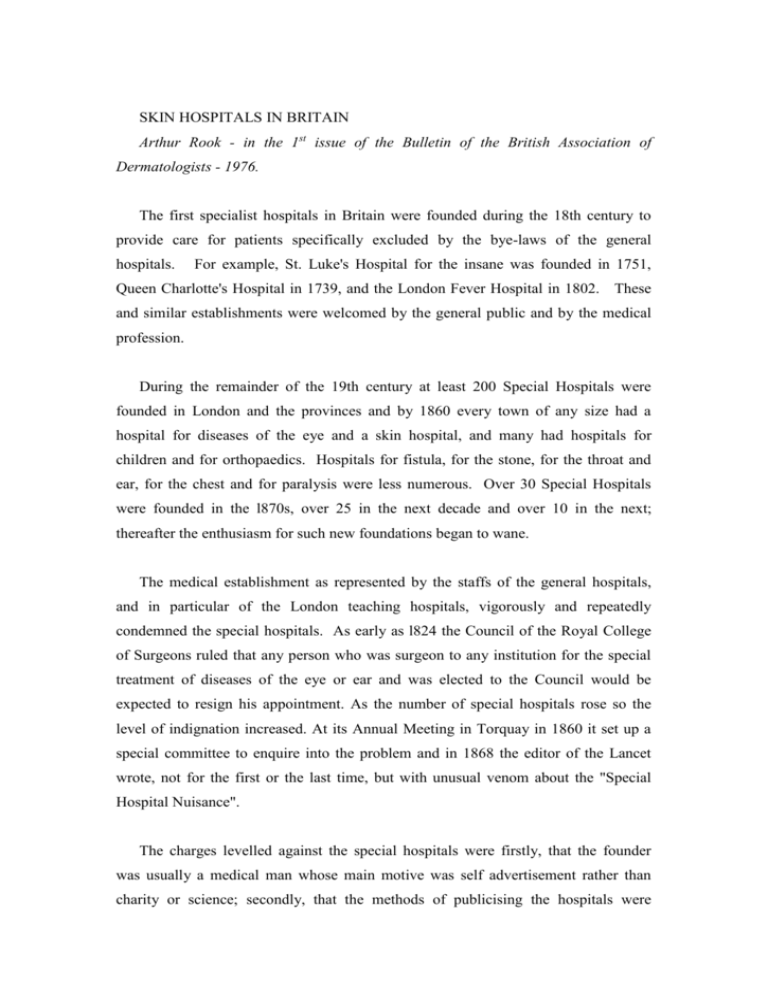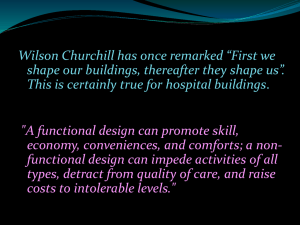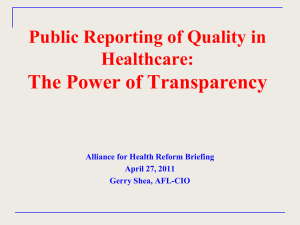SKIN HOSPITALS IN BRITAIN - British Association of Dermatologists
advertisement

SKIN HOSPITALS IN BRITAIN Arthur Rook - in the 1st issue of the Bulletin of the British Association of Dermatologists - 1976. The first specialist hospitals in Britain were founded during the 18th century to provide care for patients specifically excluded by the bye-laws of the general hospitals. For example, St. Luke's Hospital for the insane was founded in 1751, Queen Charlotte's Hospital in 1739, and the London Fever Hospital in 1802. These and similar establishments were welcomed by the general public and by the medical profession. During the remainder of the 19th century at least 200 Special Hospitals were founded in London and the provinces and by 1860 every town of any size had a hospital for diseases of the eye and a skin hospital, and many had hospitals for children and for orthopaedics. Hospitals for fistula, for the stone, for the throat and ear, for the chest and for paralysis were less numerous. Over 30 Special Hospitals were founded in the l870s, over 25 in the next decade and over 10 in the next; thereafter the enthusiasm for such new foundations began to wane. The medical establishment as represented by the staffs of the general hospitals, and in particular of the London teaching hospitals, vigorously and repeatedly condemned the special hospitals. As early as l824 the Council of the Royal College of Surgeons ruled that any person who was surgeon to any institution for the special treatment of diseases of the eye or ear and was elected to the Council would be expected to resign his appointment. As the number of special hospitals rose so the level of indignation increased. At its Annual Meeting in Torquay in 1860 it set up a special committee to enquire into the problem and in 1868 the editor of the Lancet wrote, not for the first or the last time, but with unusual venom about the "Special Hospital Nuisance". The charges levelled against the special hospitals were firstly, that the founder was usually a medical man whose main motive was self advertisement rather than charity or science; secondly, that the methods of publicising the hospitals were ethically offensive and, thirdly, that the hospitals drew material away from the teaching hospitals. The first two criticisms were unquestionably justifiable in many instances; the third was seldom true, at least during the early years of the existence of each hospital, for the many that succeeded owed their success to the fact that they provided a service which the general hospitals were not yet prepared to offer. As far as dermatology is concerned the skin hospitals not only provided specialist advice at a time when it was not available in most general hospitals; they also provided teaching and experience for many of the future dermatologists to the general hospitals. For example, Jonathan Hutchinson was Assistant to James Startin at the London Hospital for Diseases of the Skin, Blackfriars, from 1862 to 1865, when he was elected to the staff. He began to teach there in l866. Some of the skin hospitals may have been of little account, but collectively they made a massive contribution to the development of dermatology in Britain. A fully documented history of these hospitals is in preparation, but unfortunately the records of many of the hospitals no longer in existence, notably the Blackfriars Hospital, cannot be traced; they are not in the possession of the appropriate National, County or City Librarian or Archivist. The Willan Librarian will be most grateful if any reader of this Bulletin can inform him of the whereabouts of minute books and other records of the hospitals not marked with an asterisk on the attached list. He will be grateful also for information about other skin hospitals. They may well have existed in towns such as Nottingham, Cheltenham or Newcastle. THE BRITISH SKIN HOSPITAL * Present location of the hospital records known. Date of Foundation 18l9 1819 1841 1844 (or earlier) 1851 1857 1861 * 1862 * 1863 * 1863 * 1864 1864 1865 1866 1866 1880 * 1883 1884 * 1885 1886 1887 1890 * 1898 1899 * 1899 Royal London and Westminster Infirmary for the Treatment of Cutaneous Diseases, Gt. Marlborough Street. Dublin Infirmary for Diseases of the Skin, 20 Moon Street (closed 1836). London Hospital for Diseases of the Skin, Blackfriars Dispensary for Diseases of the Skin, Blenheim Street. London. Western Skin Hospital, 179 Great Portland Street. Leeds. Dispensary for Diseases of the Skin (? closed 1885-1889). Glasgow Skin Dispensary (closed 1908). Liverpool Hospital for Cancer and Skin Diseases (now the Liverpool Clinic, l Myrtle Street). Liverpool Dispensary for Diseases of the Skin (later the St. George's Hospital for Diseases of the Skin). London. St. John's Hospital for Diseases of the Skin. British Hospital for Skin Diseases, Great Marlborough Street. National Institution for Diseases of the Skin, Gray’s Inn Rd Belfast Hospital for Skin Diseases (closed after air-raid damage in 1941) Bath. Dispensary for Diseases of the Skin (closed 1913). London. City Hospital for Diseases of the Skin, City Road Birmingham and Midland Hospital for Skin Diseases. Bristol Institution for Diseases of the Skin (in l888 became the Bristol Institution for Skin and General Diseases: closed 1900). Manchester Skin Hospital (now the Manchester and Salford Hospital for Skin Diseases). Bristol Dispensary for the Treatment of Diseases of the Skin (apparently closed 1895). Glasgow Cancer and Skin Institution London Skin Hospital, Fitzroy Square (previously at 47 Cranbourne Street, W.I.). Chester and District Skin Dispensary. Leicester Institute for Diseases of the Skin. Dublin. The Hospital for Diseases of Skin and Cancer (now St. Anne's Hospital). Liverpool Skin Hospital (closed 1919).






